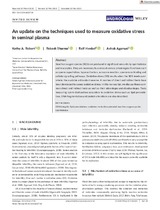| dc.contributor.author | Henkel, R | |
| dc.contributor.author | Robert, K.A | |
| dc.contributor.author | Sharma, R | |
| dc.date.accessioned | 2021-05-11T11:39:19Z | |
| dc.date.available | 2021-05-11T11:39:19Z | |
| dc.date.issued | 2021 | |
| dc.identifier.citation | Henkel, R. et al. (2021). An update on the techniques used to measure oxidative stress in seminal plasma. Andrologia,53(2),e13726 | en_US |
| dc.identifier.issn | 0303-4569 | |
| dc.identifier.uri | 10.1111/and.13726 | |
| dc.identifier.uri | http://hdl.handle.net/10566/6136 | |
| dc.description.abstract | Reactive oxygen species (ROS) are produced in significant amounts by spermatozoa and leucocytes. They are necessary to carry out various physiological functions such as sperm capacitation, hyperactivation, acrosome reaction, sperm-zona binding and cellular signalling pathways. Oxidative stress (OS) results when the ROS levels overwhelm the available antioxidant reserve. A number of direct and indirect tests have been developed to assess oxidative stress. In this manuscript, we discuss these common direct and indirect tests as well as their advantages and disadvantages. Tests measuring sperm dysfunction secondary to oxidative stress such as lipid peroxidation, DNA fragmentation and protein alterations are also described. | en_US |
| dc.language.iso | en | en_US |
| dc.publisher | Blackwell Publishing Ltd | en_US |
| dc.subject | DNA integrity | en_US |
| dc.subject | Lipid peroxidation | en_US |
| dc.subject | Oxidation–reduction potential | en_US |
| dc.subject | Reactive oxygen species | en_US |
| dc.subject | Spermatozoa | en_US |
| dc.title | An update on the techniques used to measure oxidative stress in seminal plasma | en_US |
| dc.type | Article | en_US |

